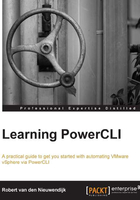
What this book covers
Chapter 1, Introduction to PowerCLI, gets you started using PowerCLI. First, you will see how to download and install PowerCLI. Then, you will learn to connect to and disconnect from the vCenter and ESXi servers and retrieve a list of all of your hosts and virtual machines.
Chapter 2, Learning Basic PowerCLI Concepts, introduces the Get-Help, Get-Command, and Get-Member cmdlets. It explains the difference between PowerShell Providers and PSDrives. You will see how you can use the raw vSphere API objects from PowerCLI and how to use the New-VIProperty cmdlet to extend a PowerCLI object.
Chapter 3, Working with Objects in PowerShell, concentrates on objects, properties, and methods. This chapter shows how you can use the pipeline to use the output of one command as the input of another command. You will learn how to use the PowerShell object cmdlets and how to create your own PowerShell objects.
Chapter 4, Managing vSphere Hosts with PowerCLI, covers the management of the vSphere ESXi servers. You will see how to add hosts to the vCenter server and how to remove them. You will work with host profiles, host services, Image Builder, and Auto Deploy, as well as with the esxcli command and the vSphere CLI commands from PowerCLI.
Chapter 5, Managing Virtual Machines with PowerCLI, examines the lifecycle of virtual machines—from creating to removing them. Creating templates, updating VMware Tools and upgrading virtual hardware, running commands in the guest OS, and configuring fault tolerance are some of the topics discussed in this chapter.
Chapter 6, Managing Virtual Networks with PowerCLI, walks you through vSphere Standard Switches and vSphere Distributed Switches, port groups, and network adapters. It shows you how to configure host networking and how to configure the network of a virtual machine.
Chapter 7, Managing Storage with PowerCLI, explores creating and removing datastores and Datastore Clusters, working with Raw Device Mapping, configuring software iSCSI initiators, Storage I/O Control, and Storage DRS.
Chapter 8, Managing High Availability and Clustering with PowerCLI, covers HA and DRS clusters, DRS rules and DRS groups, resource pools, and Distributed Power Management.
Chapter 9, Managing vCenter with PowerCLI, shows you how to work with privileges, work with roles and permissions, manage licenses, configure alarm definitions, alarm action triggers, and retrieve events.
Chapter 10, Reporting with PowerCLI, concentrates on retrieving log files and log bundles, performance reporting, exporting reports to CSV files, generating HTML reports, sending reports by e-mail, and reporting the health of your vSphere environment with the vCheck script.